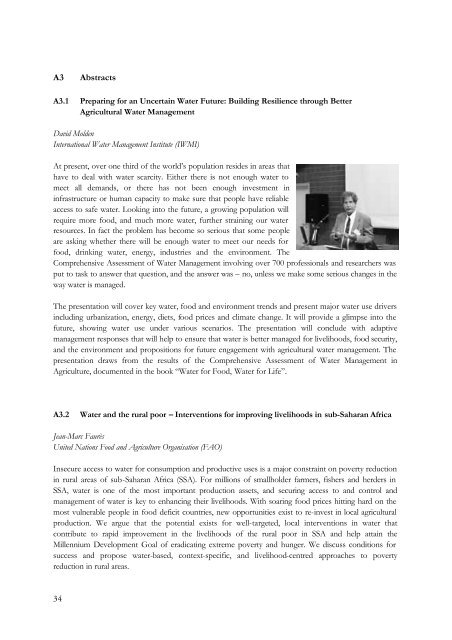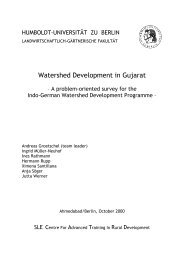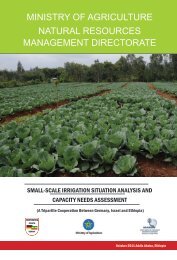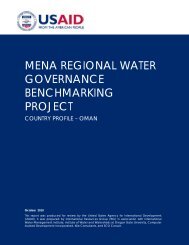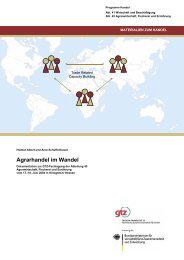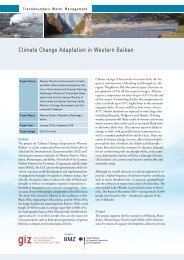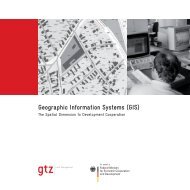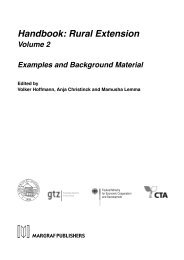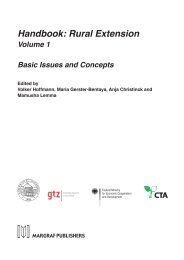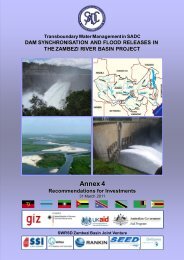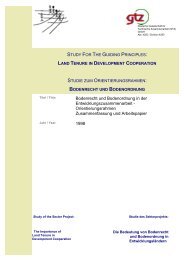Wasser in der Landwirtschaft - agriwaterpedia.info
Wasser in der Landwirtschaft - agriwaterpedia.info
Wasser in der Landwirtschaft - agriwaterpedia.info
Sie wollen auch ein ePaper? Erhöhen Sie die Reichweite Ihrer Titel.
YUMPU macht aus Druck-PDFs automatisch weboptimierte ePaper, die Google liebt.
A3<br />
Abstracts<br />
A3.1 Prepar<strong>in</strong>g for an Uncerta<strong>in</strong> Water Future: Build<strong>in</strong>g Resilience through Better<br />
Agricultural Water Management<br />
David Molden<br />
International Water Management Institute (IWMI)<br />
At present, over one third of the world’s population resides <strong>in</strong> areas that<br />
have to deal with water scarcity. Either there is not enough water to<br />
meet all demands, or there has not been enough <strong>in</strong>vestment <strong>in</strong><br />
<strong>in</strong>frastructure or human capacity to make sure that people have reliable<br />
access to safe water. Look<strong>in</strong>g <strong>in</strong>to the future, a grow<strong>in</strong>g population will<br />
require more food, and much more water, further stra<strong>in</strong><strong>in</strong>g our water<br />
resources. In fact the problem has become so serious that some people<br />
are ask<strong>in</strong>g whether there will be enough water to meet our needs for<br />
food, dr<strong>in</strong>k<strong>in</strong>g water, energy, <strong>in</strong>dustries and the environment. The<br />
Comprehensive Assessment of Water Management <strong>in</strong>volv<strong>in</strong>g over 700 professionals and researchers was<br />
put to task to answer that question, and the answer was – no, unless we make some serious changes <strong>in</strong> the<br />
way water is managed.<br />
The presentation will cover key water, food and environment trends and present major water use drivers<br />
<strong>in</strong>clud<strong>in</strong>g urbanization, energy, diets, food prices and climate change. It will provide a glimpse <strong>in</strong>to the<br />
future, show<strong>in</strong>g water use un<strong>der</strong> various scenarios. The presentation will conclude with adaptive<br />
management responses that will help to ensure that water is better managed for livelihoods, food security,<br />
and the environment and propositions for future engagement with agricultural water management. The<br />
presentation draws from the results of the Comprehensive Assessment of Water Management <strong>in</strong><br />
Agriculture, documented <strong>in</strong> the book “Water for Food, Water for Life”.<br />
A3.2 Water and the rural poor – Interventions for improv<strong>in</strong>g livelihoods <strong>in</strong> sub-Saharan Africa<br />
Jean-Marc Faurès<br />
United Nations Food and Agriculture Organisation (FAO)<br />
Insecure access to water for consumption and productive uses is a major constra<strong>in</strong>t on poverty reduction<br />
<strong>in</strong> rural areas of sub-Saharan Africa (SSA). For millions of smallhol<strong>der</strong> farmers, fishers and her<strong>der</strong>s <strong>in</strong><br />
SSA, water is one of the most important production assets, and secur<strong>in</strong>g access to and control and<br />
management of water is key to enhanc<strong>in</strong>g their livelihoods. With soar<strong>in</strong>g food prices hitt<strong>in</strong>g hard on the<br />
most vulnerable people <strong>in</strong> food deficit countries, new opportunities exist to re-<strong>in</strong>vest <strong>in</strong> local agricultural<br />
production. We argue that the potential exists for well-targeted, local <strong>in</strong>terventions <strong>in</strong> water that<br />
contribute to rapid improvement <strong>in</strong> the livelihoods of the rural poor <strong>in</strong> SSA and help atta<strong>in</strong> the<br />
Millennium Development Goal of eradicat<strong>in</strong>g extreme poverty and hunger. We discuss conditions for<br />
success and propose water-based, context-specific, and livelihood-centred approaches to poverty<br />
reduction <strong>in</strong> rural areas.<br />
34


